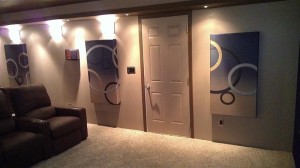Practical Guide to Home Theater Acoustics
Regular price: $14 USD
Our price: $12.60 USD
Make sure to use
coupon code 'CURTPALME'

|
|
|
Payment methods include PayPal
and all major credit cards
(PayPal account not needed to pay by credit card).
Our payment processor will automatically convert the amount
to your local currency.
This product is a
digital download available for immediate access upon payment. No
shipping.
|
A practical guide to home theater acoustics, written for the everyday
home theater enthusiast.
In the process of creating a great sounding home
theater, acoustics have to play a big part of the project.
Most enthusiasts find however that as soon as they begin to study acoustics
they're quickly buried in physics, math, formulas, and calculations.
The Practical Guide to Home
Theater Acoustics is a common sense set of best practices,
making it much easier to follow.
The acoustics of your room do not need to be thought of as something that only the most gifted math and
science majors can understand. Everyone can learn the fundamentals and apply
that knowledge in a practical way to their own rooms and theaters.

Learn these core principles, these common sense applications, that will
bring the best out of your home theater sound.
A home theater where you:
- Hear the dialogue clearly
- Don't have to keep turning the volume up during quiet scenes and down
during loud scenes
- Have clear and powerful bass (never boomy)
- Have an even response throughout the room
- Hear the surround sound as it was intended
All of the critical topics of acoustics are covered, written in a
conversational tone without any complex math. Here is the lesson list, from the
Table of Contents:
Lesson One: Overview of Sound
Lesson Two: The Role of the Room
Lesson Three: Sound Isolation Maters
Lesson Four: Reflection
Lesson Five: Diffusion
Lesson Six: Absorption
Lesson Seven: Bass Traps
Lesson Eight: Core Recommendations
Lesson Nine: Acoustic Treatment Examples
Practical Home Theater Acoustics answer questions such as:
- What are acoustic treatments anyway?
- What does it mean to measure a room?
- What are bass traps, and why do I need them?
- Where should I put absorption panels?
- Am I supposed to have diffusion in my theater?
- How do I find first reflection points?
- How does soundproofing impact acoustics?
- What the heck are room modes?
- What are the most cost effective treatments?
The last lesson, Acoustic Treatment Examples, shows actual example treatments
as created by various home theater owners. Photos are shown with the
steps these owners followed to create their own panels, bass traps, and wall
treatments.
There is theory in this guide, without it you would have no foundation for
the application. The primary purpose of the guide is to take that theory and
then apply it to your actual home theater – the practical application is the
key. The end goal is for you to have some basis in the theory, and then go ahead
and use that to create your own acoustic treatments.
FAQ
Is acoustics not already covered in
The Home Theater Course?
The Home Theater Course has a 7 page overview of acoustics but does
not give you the level of detail that this 105 page guide does. Think of
this guide as an add-on.
Is this guide filled with math?
No. The goal was to discuss these issues with as
little math and physics as possible. There are plenty of well-researched
and extensive sources for the science, the physics, and the math of
acoustics.
If I’m an Acoustics Pro will I like this guide?
Probably not. This guide is not written like a textbook and it is not filled
with science. It is written for the everyday home theater enthusiast, it is not
written for an Acoustics or industry pro.
Will I get my download right away?
Yes, the system is automated, so 24 hours a day 7 days a week, you can order
and login to download.
Will anything be shipped to me?
No, this is an all digital offering, there will be no physical product
shipped.
Can I print this out at home?
Yes, if you prefer to have something printed, feel free to do so.
See the official
forum thread
Questions, comments or feedback should be directed to:
kal@curtpalme.com
|





